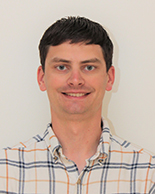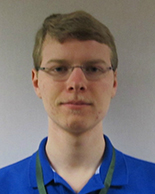Three FRIB graduate students selected for U.S. Department of Energy Office of Science Graduate Student Research Program
Share this article:
Share this article:
Students will perform research at national laboratories
The U.S. Department of Energy Office of Science (DOE-SC) selected three Facility for Rare Isotope Beams (FRIB) graduate students at Michigan State University (MSU) for the Office of Science Graduate Student Research (SCGSR) program’s 2021 Solicitation 1 cycle. Through training and access to facilities and resources at DOE national laboratories, SCGSR prepares graduate students to enter jobs of critical importance to the DOE mission.
“The DOE Office of Science provides the scientific foundation for solutions to some of our nation’s most complex challenges, and now more than ever we need to invest in a diverse, talented pipeline of scientists, engineers, and entrepreneurs who can help us build a brighter future,” said Dr. Harriet Kung, Deputy Director for Science Programs in the Office of Science. “These outstanding students will help us tackle mission-critical research at our labs as this experience helps them begin a successful and rewarding career.”
The three FRIB winners are:
Scott Essenmacher

An FRIB graduate assistant, Essenmacher’s area of study is radiochemistry for nuclear security applications. He is pursuing a PhD in nuclear chemistry through MSU’s Department of Chemistry. He will perform research at Los Alamos National Laboratory (LANL) through SCGSR.
Regarding his research, Essenmacher explained that simulation models for the numerous nuclear reactions that occur in catastrophic events, such as supernovae and nuclear detonations, use data on the probabilities for those nuclear reactions to occur, a.k.a. nuclear reaction cross sections, to predict the yields of the products (i.e. energy, isotopes of various elements, etc.). The more accurate the nuclear reaction cross section data are, the more accurate the simulation models can become. To obtain the most accurate data, it is desirable to directly measure the cross section for a reaction between high-energy projectiles and a highly pure target. These types of measurements have been done for many stable isotopes and a few radioisotopes, but not all of them. One isotope for which these measurements have not been done is vanadium-48, a radioisotope of vanadium. The goal of this research project is to develop a procedure for producing a highly pure vanadium-48 target for direct nuclear reaction cross section measurement studies.
“At LANL, I will be able to utilize a new metal-deposition platform to develop a novel radioactive target production method, compare this new technique with a more traditional production method, and validate both target fabrication protocols by manufacturing and characterizing vanadium-48 targets inside hot cells,” he said.
Gabriel Given

An FRIB graduate assistant, Given’s area of study is nuclear physics. He is pursuing a PhD in nuclear physics through MSU’s Department of Physics and Astronomy. He will perform research at LANL through SCGSR.
Regarding his research, Given explained that inside neutron stars, the neutron matter becomes a superfluid. The mechanisms for superfluidity vary depending on the density of the neutron matter.
“I’m interested in whether these different forms of superfluidity can coexist in regions of intermediate density, and will use computer simulations to investigate this,” he said. “At LANL, I will be able to closely work with experts in the kind of simulations I am using.”
Caleb Richard Hicks

An FRIB graduate assistant, Hicks’s area of study area of study is nuclear data and nuclear-theory computing in nuclear physics. He is pursuing a dual PhD in physics through MSU’s Department of Physics and Astronomy and computational mathematics, science, and engineering through MSU’s Department of Computational Mathematics Science and Engineering. He will perform research at LANL through SCGSR.
Regarding his research, Hicks explained that in some extremely dense places, such as inside a neutron star or inside a large atom, protons and neutrons can start to behave as a type of matter called a superfluid. There are several different types of superfluid distinguished by their angular momentum. Hicks said it has already been seen that the simplest superfluid, called the s-wave superfluid, forms in the outer-core of neutron stars. He said it is thought that another kind of superfluid, called a p-wave superfluid, might form in the outer core of neutron stars. In this project, a simulation will be used to demonstrate that these superfluids are possible. The simulation is based on more fundamental laws of physics, so if it is seen that the protons and neutrons are in both the s-save and p-wave superfluids, it will be good evidence that it can happen in neutron stars or large atoms.
“We will be working closely with the research group that developed the simulation (the Diffusion Monte Carlo code) that we plan to use,” he said. “We are curious if matter can form both of these kinds of superfluid at the same time. We don't know of anything that would forbid it, but we haven't yet shown that it's possible.”
SCGSR awardees work on research projects of significant importance to the DOE-SC mission and that address societal challenges at national and international scale. Projects in this cohort span the six DOE-SC programs and cover topics like fundamental studies for energy sciences, earth systems modeling, atmospheric systems research, advanced accelerator and detector research, nuclear physics, enabling research and development for fusion energy, microelectronics, machine learning, quantum information science, and data science.
Overall, DOE-SC selected 65 graduate students representing 29 states for SCGSR’s 2021 Solicitation 1 cycle. Awardees were selected from a diverse pool of graduate applicants from institutions around the country. Selection was based on merit peer review by external scientific experts. Since 2014, the SCGSR program has provided more than 765 U.S. graduate awardees from 153 universities with supplemental funds to conduct part of their thesis research at a host DOE laboratory in collaboration with a DOE laboratory scientist.
For more information, visit the SCGSR website.
Read original press release here.
Michigan State University (MSU) establishes and operates the Facility for Rare Isotope Beams (FRIB) as a user facility for the U.S. Department of Energy Office of Science (DOE-SC), supporting the mission of the DOE-SC Office of Nuclear Physics. Hosting the most powerful heavy-ion accelerator, FRIB will enable scientists to make discoveries about the properties of rare isotopes in order to better understand the physics of nuclei, nuclear astrophysics, fundamental interactions, and applications for society, including in medicine, homeland security, and industry.
The U.S. Department of Energy Office of Science is the single largest supporter of basic research in the physical sciences in the United States and is working to address some of today’s most pressing challenges. For more information, visit energy.gov/science.

